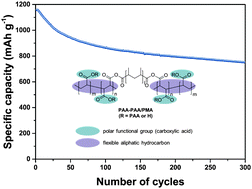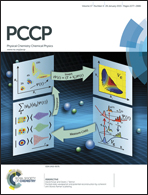The effect of an elastic functional group in a rigid binder framework of silicon–graphite composites on their electrochemical performance†
Abstract
As a means of enhancing the electrochemical performance of silicon–graphite composites, we propose a novel binder candidate that is modified by a combination of rigid and elastic functional groups on its binder framework. To provide an efficient binder that is also capable of rapid volume changes, a co-polymer binder (PAA–PAA/PMA) is synthesized by employing poly(acrylic acid) (PAA) as the main binder framework and poly(acrylic acid)-co-poly(maleic acid) (PAA/PMA) as an additional elastic polymer auxiliary. This co-polymer binder (PAA–PAA/PMA) affords a good balance of adhesive and mechanical (rigidity and elasticity) properties, which creates an excellent cycle performance with a high specific capacity (751.1 mA h g−1) and considerable capacity retention (64.9%) after 300 cycles. This is attributed to the ability of the added elastic functional group to respond flexibly to volume changes, thereby enhancing the overall uniformity of the electrode and ensuring a consistent electronic network. On the basis of these findings, it is considered that embedding an elastic functional group into the binder framework is an effective approach to improve the overall performance of Si–graphite composite electrodes.


 Please wait while we load your content...
Please wait while we load your content...